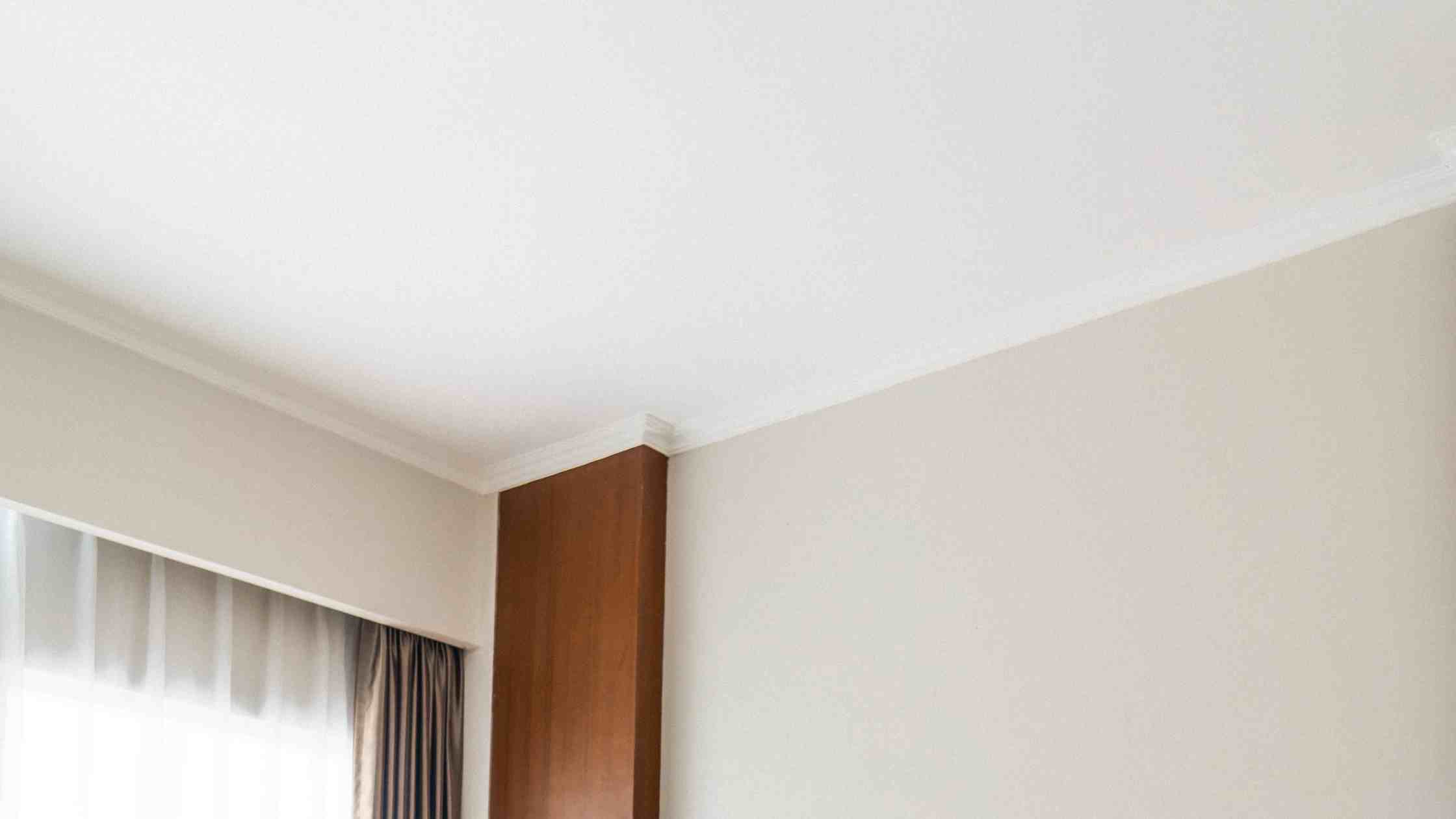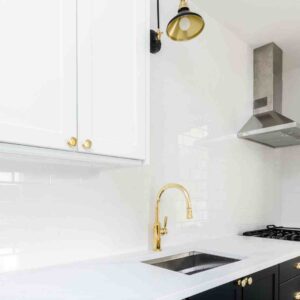The components of a drywall i.e. plasterboard and gypsum are brittle in nature. It is not advised to hang chandeliers from drywall as the maximum weight drywall can withstand is about 13 pounds (6kg) to 20 pounds (10 kg). Hanging anything less heavy around 2 pounds to 4 pounds might stay firm on the drywall but over time that weight can weaken the drywall.
An average person with average strength can easily kick the drywall and create a hole in it. From this one can get a good idea about how strong a drywall really is.
However, there are many instances where heavy-weight items are easily hanged from a drywall without making it weak. This is accomplished by identifying weak spots and strong spots of a drywall ceiling.
Identifying strong spots and weak spots in a drywall ceiling for hanging chandelier
A drywall is the strongest near the corner of the ceiling and walls (the point here ceiling and wall meets). If an object is carefully hanged a few inches away vertically from this point the drywall will withstand upto 15 pounds of weight easily.
In contrast to this if an object is hanged at the center of the drywall ceiling which is the weakest point of drywall it may not be able to withstand the weight.
A chandelier is usually hanged at the center of a room. Hence, in case of a room with a drywall ceiling chandelier is not an ideal choice. Instead choosing the lighting options which can be installed at the corners should be preferred.
can pendant lights be installed on a drywall ceiling?

Normally pedant lights can weigh around 1 pound and more depending on the material and design. Since they are required to be hanged vertically from a ceiling just like chandeliers they are not ideal for lighting in case of drywall ceiling.
Pendant lights are not hanged at corners they hang either over a table or at center point of ceiling. In case of drywall center point is the weakest spot. Hence, one should avoid installing pendant lights on drywall ceiling.
ALTERNATIVES TO CHANDELIER FOR A DRYWALL CEILING.
lighting fixtures that can be installed at the corners of the walls are the best option for lighting a room with drywall ceiling. The reason being corners are strong points in a drywall. Keeping that in mind below are the best lighting options for illuminating a room with drywalls.
led bulbs and tubes
Led bulbs are the most readily available option for illuminating a room if ceiling, as well as rest of the walls, are drywall. They can be placed at corners of the ceiling or nearer the point where wall and ceiling meets. . A19 led bulbs are ideal choice for small and medium sized rooms. A single A19 bulb can provide illumination of around 800 lumens.
Led tubes are heavy compared to led bulbs but if placed at the corner walls instead of ceilings they can also be an excellent option for illuminating the room.
Positioning of led bulbs and tubes
For even distribution of light led bulbs should be placed at a height of 8 feet from the floor.

Avoid installing led bulbs directly on the ceiling as it will require drilling the drywall which may further affect its sturdiness.
Fluorescent tubes
They are almost the same weight as led tubes of similar size. If every wall of the room is drywall then these tubes can also be installed at the corners of the wall. Place them at a minimum height of 8 feet from the floor.
If the ceiling is low then install them at the highest point where the wall and ceiling meets.
4 feet long fluorescent tubes are ideal for illuminating small and medium-sized rooms. They emit around 3000 lumens of brightness and last for a lesser time around 15000 hours compared to LEDs which lasts for 50000 hours
Wall sconces (if only ceiling is drywall and rest of walls are concrete)
Lightweight modern wall sconces are less bright compared to led tubes and bulbs but they can be used for enhancing the look of a room. A pair of wall sconce can weigh 0.01 ounce. The problem with wall sconces is that they are less bright and need to be installed slightly in the middle parts of the wall.
This many require to drill holes and ultimately weaken the drywall. Hence
If a room has ceiling made out of drywall while the rest of the walls are concrete then a heavier wall sconces can be used.
Depending on the size and bulb used the weight can increase. The total weight of the wall sconces is already shown in the respective product descriptions.
They can be placed vertically on either side of the bed or together where lighting is required the most.
Placement
As the distance from the source increases the intensity of light decreases
Wall sconces are installed at a minimum height of 4.8 to 5 feet from the floor to obtain maximum light from them. Wall sconces mostly come in a pair. They can be placed both together with a minimum, space of 6 inches between them or individually at desired locations.
Table Lamps

Table lamps are excellent options to get sufficient brightness for reading purposes at night. Table lamps incorporate both led as well as fluorescent bulbs. Most table lamps have light bulbs included with them.
If however not included the manufactures clearly mentions the required bulb in the product description. Generally, e26 base is used among table lamps. For that base, a standard 60 watts equivalent A19 led bulb can be used.
Depending on the bulb used, table lamps emit as much as 800 lumens of brightness. They are plugins and do not require drilling the walls.
how drilling affects drywall strength
Drywalls are not made to be strong like concrete walls. Drilling into a drywall makes it even more fragile if a hole is made in the center point of drywall or near to it. If a nail is drilled into drywall for holding something like a painting. It may hold the painting but not for a long time. Soon the painting with the nail will fall on the floor.
Avoid drilling a drywall at its center point as much as possible. After hanging something drywall will not be able to counter the force of gravity.
ADDITIONAL INFORMATION
TYPES OF DRYWALLS AND THEIR STRENGTH
This will help you to get a good idea of what kind of drywall is strongest to hold a particular weight.
White Board Drywall
This is the cheapest drywall also known as regular drywall composed of calcium sulphate dihydrate and paper. It is readily used in construction for structuring home walls. Composing of only a few ingredients this drywall is not water-resistant, neither do fire-resistant. Gypsum, paper as well as some other additives make it fairly brittle.
Such drywalls can however withstand a limited weight of lighting if weight is installed at their strong points.
Moisture-Resistant Green Board Drywall
This type of drywall has a moisture-resistant paper on one side while gypsum and other additives comprising the other side. It is moisture resistant but this feature does not account for any added strength in the drywall itself. The strength is almost similar to regular drywalls.
Water-resistant Blue-Board Drywall
This drywall have special waterproofing materials along with gypsum, silica, paper and clay. This makes a blue board drywall incredibly resistant to water. These are not fire-resistant.
However, the strength of this drywall is relatively weak as compared to paperless drywalls or other much thicker drywalls
Paperless Drywall
Just like regular drywall, paperless drywall also has a core of gypsum. But instead of paper, a sheet of fiberglass is used to sandwich gypsum inside.
This drywall is stronger than regular drywall but not by a large margin. They are still fairly brittle and one should avoid hanging things directly from the center points of such drywalls.
Drywall (Type X)
These are fire resistant drywalls and have relatively high strength compared to regular drywall with paper as well as paperless drywall.
These are not fire-proof but due to addition of tightly packed fiber glass with gypsum makes them resistant to fire for a limited time.


